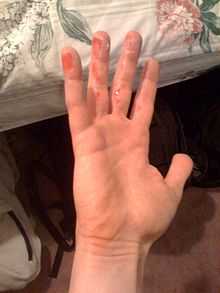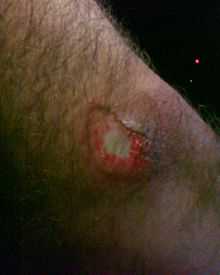Friction burn


A friction burn is a form of abrasion caused by the friction of skin rubbing against a surface. A friction burn may also be referred to as skinning, chafing, or by the surface causing the burn such as rope burn, carpet burn or rug burn. As friction also generates heat, extreme cases of chafing may result in genuine burning of the outer layers of skin.[1]
The dermal papillae may be exposed after top layers of the dermis (stratum corneum, stratum granulosum, stratum spinosum and stratum basale) have been removed. This is often uncomfortable and even painful, but rarely results in bleeding.
A person's own skin (or the skin of another person) may be sufficient to act as an abrasive surface to cause friction burn. More commonly, friction with abrasive surfaces, including clothing, carpet, or rope, can lead to a friction burn. Common places at which skin-to-skin chafing can occur are between the thighs and under the armpits. Friction burns are very common with clothing such as trousers on the knees caused by playing sport or sliding on wooden surfaces
A risk of friction burns is infection.
Treatments
Treatments for friction burns usually involve application of an anti-inflammatory cream. Pain relieving medication may also be taken.[2]
One of the underlying factors behind abdominal chafing (inguinal friction) may be obesity, and weight loss may be indicated as a preventive measure.
References
- ↑ Agrawal, A.; Raibagkar, S.C.; Vora, H.J. (31 March 2008). "Friction Burns: Epidemiology and Prevention". Annals of Burns and Fire Disasters 21 (1): 1. PMC 3188131. PMID 3188131.
- ↑ Terrie, Yvette C. "First Aid for Minor Burns and Wounds". Pharmacy Times. Intellisphere. Retrieved 11 November 2014.